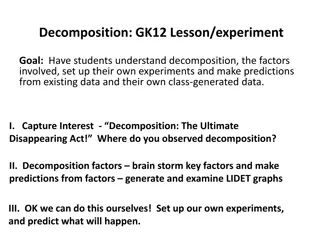Understanding Factorial Designs in Experiments
Factorial designs in experiments allow researchers to study the effects of multiple independent variables simultaneously. This type of design enables the examination of main effects and interactions between factors, providing a comprehensive understanding of the research variables. Main effects refer to the differences in means across levels of one factor, while interactions occur when the effects of one factor depend on different levels of another factor. By utilizing factorial designs, researchers can gain valuable insights into complex relationships within their studies.
Download Presentation

Please find below an Image/Link to download the presentation.
The content on the website is provided AS IS for your information and personal use only. It may not be sold, licensed, or shared on other websites without obtaining consent from the author. Download presentation by click this link. If you encounter any issues during the download, it is possible that the publisher has removed the file from their server.
E N D
Presentation Transcript
Factorial Designs Chapter 11
Class Temperature & learning Temperature Exam Score High 80 Low 80
Add a second factor (gender) Chart Title 86 84 82 80 78 76 74 72 70 Male Female High Low
What about another factor (test level)?
Factorial designs Allow experiments to have more than one independent variable.
Example This example has two levels for the alcohol factor ( factor A) and three levels for the caffeine factor ( factor B), and can be described as a 2X3 ( read as two by three ) factorial design The total number of treatment conditions can be determined by multiplying the levels for each factor.
Main effect The mean differences among the levels of one factor are called the main effect of that factor.
Interaction An interaction between factors ( or simply an interaction) occurs whenever two factors, acting together, produce mean differences that are not explained by the main effects of the two factors.
+25 +25 +50 +50 +50 +25 +25 Example 1- Main effect only
+10 +10 +20 +80 +50 +40 +40 Example 2 - Interaction
Alternative Definitions of an Interaction When the effects of one factor depend on the different levels of a second factor, then there is an interaction between the factors. A second alternative definition of an interaction focuses on the pattern that is produced when the means from a two- factor study are presented in a graph.
When the results of a two- factor study are graphed, the existence of nonparallel lines ( lines that cross or converge) is an indication of an interaction between the two factors. ( Note that a statistical test is needed to determine whether the interaction is significant.)
Main effect Factor A Not B sample Possible outcomes Main effect for A & B No main effect Interaction A&B
Important If the analysis results in a significant interaction, then the main effects, whether significant or not, may present a distorted view of the actual outcome.
5 Types of Mixed Designs A factorial study that combines two different research designs is called a mixed design. 1. Both Experimental Both between 2. Both Experimental Both within 3. Both Experimental - Onebetween- subjects factor and one within- subjects factor. 4. Both factors are non-manipulated (pre existing) 5. One experimental & one non-experimental
Example (between/Within) music The graph shows the pattern of results obtained by Clark and Teasdale ( 1985). The researchers showed participants a list containing a mixture of pleasant and unpleasant words to create a within- subjects factor ( pleasant/ unpleasant). The researchers manipulated mood by dividing the participants into two groups and having one group listen to happy music and the other group listen to sad music, creating a between- subjects factor ( happy/ sad). Finally, the researchers tested memory for each type of word.
Quasi- independent variables It also is possible to construct a factorial study for which all the factors are non-manipulated, quasi- independent variables.
Example Factor B Psychology 6 20 History 19 5 Male Female Memory Scores Factor A 25 20 15 Male Female 10 5 0 Psychology History
One Experimental one non-experimental In the behavioral sciences, it is common for a factorial design to use an experimental strategy for one factor and a quasi- experimental or non- experimental strategy for another factor.
Example Manipulate Pre-existing
Higher- Order Factorial Designs The basic concepts of a two- factor research design can be extended to more complex designs involving three or more factors; such designs are referred to as higher- order factorial designs. A three- factor design, for example, might look at academic performance scores for two different teaching methods ( factor A), for boys versus girls ( factor B), and for first- grade versus second- grade classes ( factor C).























